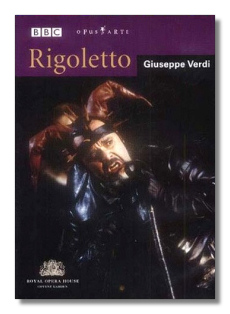
The Internet's Premier Classical Music Source
Related Links
- Verdi Reviews
- Latest Reviews
- More Reviews
-
By Composer
-
Collections
DVD & Blu-ray
Books
Concert Reviews
Articles/Interviews
Software
Audio
Search Amazon
Recommended Links
Site News
 DVD Review
DVD Review
Giuseppe Verdi

Rigoletto
- Paolo Gavanelli (Rigoletto)
- Christine Schäfer (Gilda)
- Marcelo Álvarez (Duke of Mantua)
- Eric Halfvarson (Sparafucile)
- Graciela Araya (Maddalena)
- Giovan Battista Parodi (Monterone)
- Elizabeth Sikora (Giovanna)
Orchestra & Chorus of the Royal Opera House, Covent Garden/Edward Downes
BBC Opus Arte OA0830D DDD 169 minutes, including special features
Anamorphic Widescreen 1.78:1; Audio: Italian (Dolby Digital 5.1)
Available subtitles: English, Spanish, German, French, Dutch
Rigoletto is turning out to be especially popular on DVD; there are now three choices of which I am aware. I reviewed the Ponnelle version with Pavarotti and Wixell (on Decca) for Fanfare almost a year ago, and I liked it fine. It is, however, a filmed version, with singers miming to pre-recorded vocal tracks, and while it is dramatic, it is not very theatrical. This time around, we never forget that we're in the Royal Opera House, and that's no bad thing, as – perhaps paradoxically – it draws viewers into the action more than the film does.
This production is characterized by its intentional seediness. Rigoletto and Sparafucile seem to live in some kind of shanty town, and even the Duke's "palace" is affected by post-nuclear decay and disrepair. The ripped chain-link fences and aluminum siding contradict the costumes, which are vaguely of the period Hugo and Verdi intended. The opening scene finds a small orgy in progress, with full frontal nudity from both genders, plus simulated intercourse. (You might want to send the young ones to bed before watching this.)
Although parts of the production flirt with self-indulgence, much of the singing and acting here is sublime. In the title role, Gavanelli strongly contrasts his satyr-like behavior in the Duke's court with his crushing love for Gilda. His range of facial expressions is large, and he moves around the stage naturally – sometimes with agility, sometimes in spiritual pain – on his crutches. As for his vocalism, he seems born to have sung the deformed jester. He pours out sustained Italianate phrases to express his love for his daughter and his contempt for the courtiers. If at times he is a little under pitch, he can be forgiven, given the live conditions and the intensity of his portrayal. Schäfer, looking like Tilda Swinton in Acts I and II and like Laurie Anderson in Act III, is a heartbreakingly credible Gilda. She is a physically striking young woman and a very expressive actress. Her lyric soprano is meltingly lovely, with never a trace of twitter, even in "Caro nome." We'll be hearing a lot more from her in coming years. Together, she and Gavanelli could wring tears from the stoniest hearts. Álvarez, another relative newcomer, gives us a Duke sung in the Domingo and Carreras tradition, all Latin suaveness and thrillingly sonorous. As an actor, he is less astute, although he is successful in creating the portrait of a spoiled, superficial ruler, and he seems to come alive in the last act. (Perhaps he had a few coffees during the intermission.) The other singers all deserve praise, particularly Araya's rich-toned Maddalena, Parodi's full-bore Monterone, and Sikora's pandering Giovanna. Downes conducts the orchestra and chorus like a true Italian, and he restores some of the traditional cuts, both large and small.
Extra features on this DVD include a brief BBC documentary on Verdi (meet the members of the Verdi fan club who have named themselves after the Maestro's operas!) and an interview with director David McVicar. The latter is particularly interesting because it reveals, unintentionally, that his theories about the opera are not completely born out by his production – a classic example of a concept lost in the execution.
The image is 16x9 anamorphic and easy on the eyes, although there is a lot of darkness in the production itself. There are optional subtitles in English. The digital surround sound recording is among the finest I've heard on DVD yet.
Highly recommended, particularly for the performances of the three leads.
Copyright © 2002, Raymond Tuttle


















